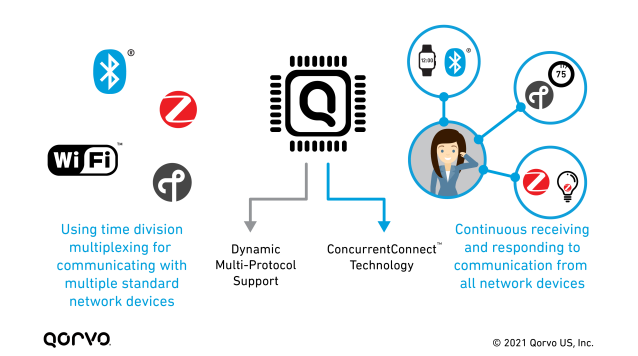Making Matter Work – and Making Smart Homes Smarter
March 30, 2023
Blog

Don’t you wish smart homes were a little bit more, well, smart? If you’ve ever struggled to set up multiple devices from several companies, then you know the frustration it can cause.
This is the issue being addressed by Matter™, a new wireless standard supported by companies including Amazon, Apple, Google, and Qorvo, and overseen by the Connectivity Standards Alliance (CSA). The alliance members have taken an open-source approach to developing the new protocol, enabling broad, global adoption across the smart home and smart lighting sector.
With nearly 600 members, the alliance has the scale to deliver its vision of an interoperable smart home. Matter will simplify setup and use of Internet of things (IoT) products and smart home devices and systems all while promising reliable connectivity and robust security.
What People Want
Consumers want user-friendly products that are easy to set up and work consistently. They should be user friendly out of the box, but this may be difficult in a lot of cases – networks have many variables and differing characteristics depending on the home itself, the products being used, and how they are configured.
Moving to the new Matter device needs to be frictionless. The product vendor needs to deliver a smooth translation from the previous standard in use, such as Zigbee, to Matter, and to ensure that the old devices in use will still work.
The smart home device should be reliable, and must consistently deliver the right level of performance – which means it needs uninterrupted connectivity. It must also provide a high degree of security, without being difficult to manage for users. Finally, it should be small and attractive.
A Matter of Fact
Matter is based on proven internet protocol (IP) v6 technologies and defines the application layer, as well as links between layers to ensure interoperability. It can be used with different underlying network transports: right now, these can be Ethernet, Wi-Fi or thread, while Bluetooth Low Energy (BLE) is also used for commissioning devices (see Figure 1).
By using these standard network technologies, it is easier for existing products to add Matter support, as long as they already include a suitable radio. Bridges can also be used to integrate Matter devices with others, for example to enable Zigbee devices to be used in a Matter network.
Matter standardizes the most common core features to guarantee interoperability, while still enabling vendors to differentiate their products with extra capabilities. This means a smart product from one vendor, such as a light bulb, will work natively with a switch or smart home hub from a different provider – and the Matter name gives consumers the confidence this will always hold true. At the same time, developers’ time is freed up to spend on differentiation and innovation.

Figure 1: Matter architecture
Making it Work
Today's communications devices usually have some form of dynamic multi-protocol (DMP) support, but this requires different types of trade-offs. For example, a device must know when exactly to switch from Thread to BLE and back again, which may be difficult or impossible in practice.
Technologies such as Qorvo’s ConcurrentConnect enable a device to listen and communicate concurrently using multiple standards, instead of having to switch between them and only communicate on one protocol at a time. This concurrent listening enables near-instantaneous switching, so communications are fast, efficient, and have no detectable latency, thereby enabling designers to build smaller, lower cost products that are easy to support, with a reduced time to market.

Figure 2: ConcurrentConnectTM multi-channel and multi-radio technology, shown at the right of the illustration, manages communications from different standards and protocols simultaneously with no detectable latency
End customers want user-friendly, small, and attractive devices in their homes that are simple to migrate to and work reliably. And they want a trusted, industry-wide certification so they can buy interoperable products.
With backing from so many big companies, Matter looks like a standard that can deliver devices that meet those requirements at the scale the industry wants. According to ABI Research, more than 5.5 billion Matter-compliant smart home devices will ship between 2022 and 2030, making Matter a major step towards smart home standardization.
For more information, visit https://www.qorvo.com/innovation/matter.





